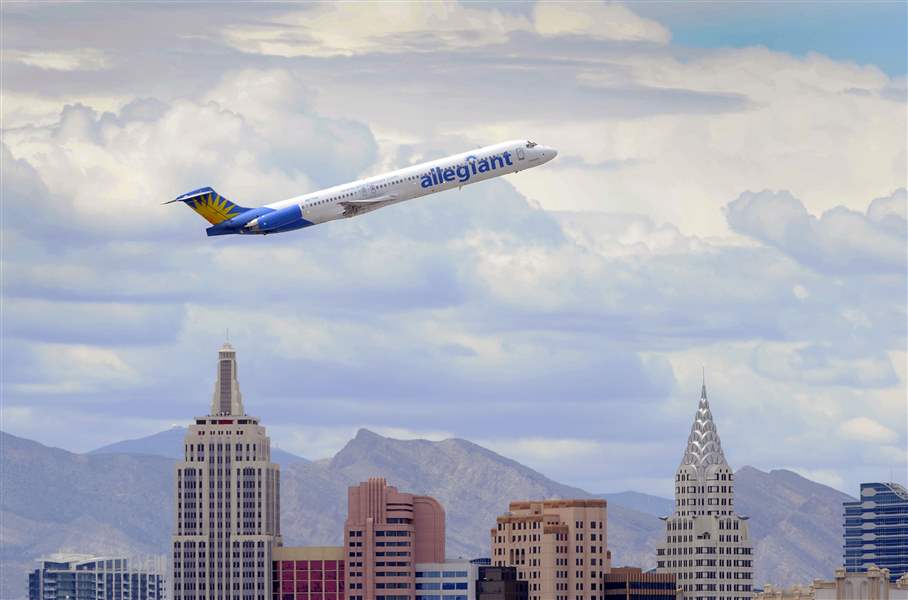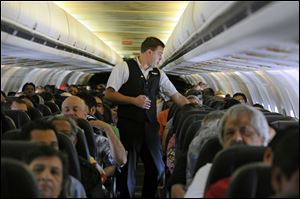
Allegiant Air thrives on routes to sunny vacation spots from often-overlooked small cities
7/13/2013
An Allegiant Air jetliner flies over the New York-New York Hotel & Casino after taking off from McCarran International Airport in Las Vegas. The low-cost carrier, based in Las Vegas, relies on additional fees, older aircraft, and lower-than-standard wages.
ASSOCIATED PRESS

An Allegiant Air jetliner flies over the New York-New York Hotel & Casino after taking off from McCarran International Airport in Las Vegas. The low-cost carrier, based in Las Vegas, relies on additional fees, older aircraft, and lower-than-standard wages.
LAS VEGAS — There are no sure things in this city — with one exception: Allegiant Air.
While other U.S. airlines have struggled during the last decade from the ups and downs of the economy and the price of jet fuel, Allegiant has been profitable for 10 straight years.
The tiny airline focuses on a niche ignored by other airlines: It only flies from small cities to sunny vacation spots.
Allegiant uses low fares and nonstop flights to entice people who otherwise wouldn’t fly. Then it pitches them hotels, rental cars, show tickets, and other entertainment, earning millions in commissions.
Passengers face fees for almost every service and amenity imaginable. At Allegiant, fees for checked baggage and changing an itinerary — common on many airlines — are just the start.
The Las Vegas-based airline charges extra to book flights online or to use a credit card. Selecting a seat in advance costs $5 to $75 each way, depending on the length of a flight. A bottle of water costs $2.
While other airlines tout aircraft with Wi-Fi and TVs in every seat, Allegiant buys old planes to avoid hefty loans. And to pack in as many passengers as possible, its seats don’t recline. But for small-town Americans with limited flight options, these inconveniences are worth it for a few days of sunshine.
“They could be the worst airline in the world and we’d fly them because we want to go to Vegas,” said Tom Mayo of Cedar Rapids, Iowa, who recently flew there with his family. “It’s our only option.”
Allegiant offers nonstop service from places such as Toledo; Owensboro, Ky.; Casper, Wyo., and Appleton, Wis., to popular destinations in Nevada, Florida, Hawaii, and Arizona.
“Typically, the best way to make money is not to compete with somebody,” said Andrew C. Levy, president of Allegiant Travel Co., who sits in a cubicle next to the rest of his staff.
Last year, 7 million passengers took a flight on Allegiant. That is a sliver of the 642 million people who took a domestic flight last year. But Allegiant earned a whopping $11.22 each way from those passengers. On average, the airline industry earned 37 cents each way, per passenger, according to Airlines for America, the industry’s lobbying group.

While other U.S. airlines have struggled with the ups and downs of the economy and oil prices, tiny Allegiant Air has been profitable for 10 straight years.
Allegiant is ruthless about keeping its costs down. Its employees are some of the lowest paid in the industry; in some cases making $20 an hour less than colleagues at other airlines. It pays cash for airplanes nearly twice as old as everyone else. It only sells directly to vacationers, refusing to pay Expedia, Orbitz, or other sites to list its flights.
And if you have a question, it will cost you: The airline doesn’t have a toll-free number.
To book a trip by phone, Allegiant charges $50 for each round-trip ticket. To book online costs $20 for each round-trip ticket. The only way to avoid the fees is to buy tickets at the airport, something fewer than 3 percent of its customers did last year.
Placing a suitcase in an overhead bin is $10 to $25. If passengers show up at the airport with a large carry-on bag and haven’t prepaid, the airline penalizes them an extra $25 to $50, depending on the route.
But what really makes Allegiant different are the commissions it earns from selling hotel rooms, rental cars, and other extras including Everglades boat tours and theme-park tickets. Last year, revenue from commissions totaled $36 million, or nearly $12 per round-trip passenger.
On a recent flight from Cedar Rapids to Las Vegas, flight attendants hawked show tickets and airport shuttles over the loudspeakers. The in-flight magazine has no stories, just ads. Flight attendants are paid extra for each item sold.
Like other discount carriers, Allegiant prefers small airports that charge lower rents, even if they aren’t the most convenient. In Orlando, that means flying into Sanford, Fla., 30 minutes farther from Walt Disney World than Orlando International Airport.
These decisions helped Allegiant post a net profit of $78 million last year on revenue of $909 million. Its 8.6 percent profit margin was the highest of any U.S. airline, making it a darling of Wall Street.
The airline began in 1998 as a charter operation with one plane. By February the next year, it had started scheduled flights between Fresno, Calif., and Las Vegas.
But business struggled. Less than two years later, it filed for bankruptcy protection. Maurice J. Gallagher, Jr., the airline’s major creditor and a founder of ValuJet Airlines, gained control and became chief executive officer. ValuJet was a low-cost carrier that changed its name to AirTran after a 1996 fatal crash in Florida.
Mr. Gallagher moved the airline from Fresno to Las Vegas; secured a lucrative contract with Harrah’s to provide charter services to its casinos in Laughlin, Nev., and Reno; and started to transform Allegiant into a low-cost carrier.
By 2003, the airline started turning profits, and it hasn’t stopped. Mr. Gallagher’s nearly 20 percent stake in the airline is now worth more than $380 million.
Allegiant benefits from paying lower salaries and having work rules that are more favorable to management than at most airlines. Attendants with 15 years of experience are paid $34 for each hour their plane is in the air — $10 to $20 less than colleagues at larger carriers. Planes and crews typically end up at their home cities overnight, avoiding hotel rooms.
Wages could shoot up. Pilots, flight attendants, and dispatchers have voted in the last two and a half years to join unions.
The airline’s used, inexpensive jets are 23 years old, on average, compared with the industry average of 14 years.
“When you have such little investment in an aircraft, you only fly it when it’s going to be full of passengers,” said Peter B. Barlow of Smith, Gambrell & Russell. “Other airlines don’t have that luxury. They need to keep their aircraft in the air in order to make the economics work.”
But older planes burn more fuel, something Allegiant combats by squeezing 166 passengers onto planes — 26 more than American Airlines has on comparable jets. They also have more mechanical problems, resulting in more delays.
One of every four Allegiant flights last year was at least 15 minutes late, the worst record in the industry, according to flight tracker FlightAware.